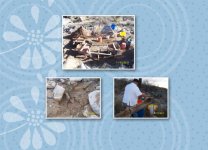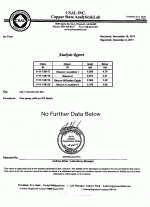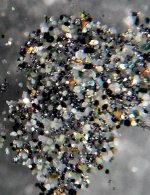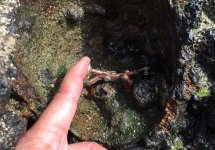Klondikeike
Full Member
- Aug 13, 2010
- 247
- 36
- Detector(s) used
- H3 element detector, JeoHunter Dual 3-D Imaging Detector
- Primary Interest:
- All Treasure Hunting
Klondike here...
Just returned from a trip to Arizona...collecting samples and getting assays done on a property I am looking at...
This first set of assays was done to confirm the presence of gold and silver, establish a value for the property, measure the property and determine how much material as well as how much god is present. Further testing will be needed to establish a mining plan. In addition, we did several "grab" samples from many locations, just panning a shovel full here and there, to detect the presence of gold...
But these assays do confirm the property is a valuable resource worthy of a small scale placer operation as you'll see below..
At first we were discouraged due to not seeing much in the way of free milling gold in our clean ups...but an enormous amount of black sands in every pan..... more than I have ever seen anywhere before...and I suspected the assays would point out that a lot of the gold is in a complex sulphide form.
And I was right... the assays show the gold per ton of black sands is at an average of 1.66 ounces (we maybe saw a few grams or so in each sample) and 3.82 ounces of silver per ton of black sands....
From our measurements, this property produces 150 pounds of black sand to every yard of raw native soil. (this was confirmed by a local geologist familiar with the property)... So by running a small plant...at 20 yards per hour, should produce about 2 ounces of gold..most of what you cannot see and about 5 ounces of silver.
I have a long time friend who owns a commercial smelter and is licensed to refine black sands, only about 85 miles away. He'll smelt all my sands for me...
Maybe some of you should team up..collect your sands together..have them assayed.. and send then to my friend..and you all split the gold and silver equally.... just a thought...
So.. how much are your black sands worth?? Twenty years ago I would have walked passed this property... but not now.. there is a lot of gold and silver here...in these black sands...No matter how you mine.. always save your black sands....
just one note.. a sluice box is limited to how much black sand it will capture... it is only maximum effective during the first couple of minutes..after that, it stars to send more over the end than it catches... therefore..if you are really interested in accumulating black sands.. in your operation, use something like Global Mining Solutions equipment.. it does a constant recovery of black sand without ever filling up...
Below are some pics from my trip...
Hope this helps someone and good luck to you all...
Klondike...
Just returned from a trip to Arizona...collecting samples and getting assays done on a property I am looking at...
This first set of assays was done to confirm the presence of gold and silver, establish a value for the property, measure the property and determine how much material as well as how much god is present. Further testing will be needed to establish a mining plan. In addition, we did several "grab" samples from many locations, just panning a shovel full here and there, to detect the presence of gold...
But these assays do confirm the property is a valuable resource worthy of a small scale placer operation as you'll see below..
At first we were discouraged due to not seeing much in the way of free milling gold in our clean ups...but an enormous amount of black sands in every pan..... more than I have ever seen anywhere before...and I suspected the assays would point out that a lot of the gold is in a complex sulphide form.
And I was right... the assays show the gold per ton of black sands is at an average of 1.66 ounces (we maybe saw a few grams or so in each sample) and 3.82 ounces of silver per ton of black sands....
From our measurements, this property produces 150 pounds of black sand to every yard of raw native soil. (this was confirmed by a local geologist familiar with the property)... So by running a small plant...at 20 yards per hour, should produce about 2 ounces of gold..most of what you cannot see and about 5 ounces of silver.
I have a long time friend who owns a commercial smelter and is licensed to refine black sands, only about 85 miles away. He'll smelt all my sands for me...
Maybe some of you should team up..collect your sands together..have them assayed.. and send then to my friend..and you all split the gold and silver equally.... just a thought...
So.. how much are your black sands worth?? Twenty years ago I would have walked passed this property... but not now.. there is a lot of gold and silver here...in these black sands...No matter how you mine.. always save your black sands....
just one note.. a sluice box is limited to how much black sand it will capture... it is only maximum effective during the first couple of minutes..after that, it stars to send more over the end than it catches... therefore..if you are really interested in accumulating black sands.. in your operation, use something like Global Mining Solutions equipment.. it does a constant recovery of black sand without ever filling up...
Below are some pics from my trip...
Hope this helps someone and good luck to you all...
Klondike...
Attachments
Upvote
0




 Ihave a question bout black sand, i have black sand in my pann and there is no gold flecks free of the black sand, but using a mignifing glass , looking at the black sand there is what looks like gold. almost microscopic. could this be extremely fine gold, or am i looking at pyrite.
Ihave a question bout black sand, i have black sand in my pann and there is no gold flecks free of the black sand, but using a mignifing glass , looking at the black sand there is what looks like gold. almost microscopic. could this be extremely fine gold, or am i looking at pyrite.

 .
.


